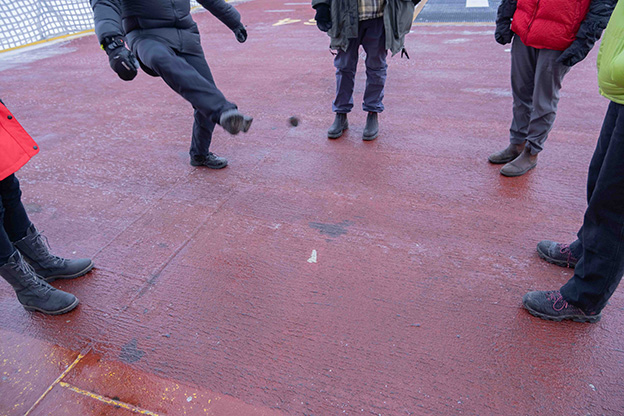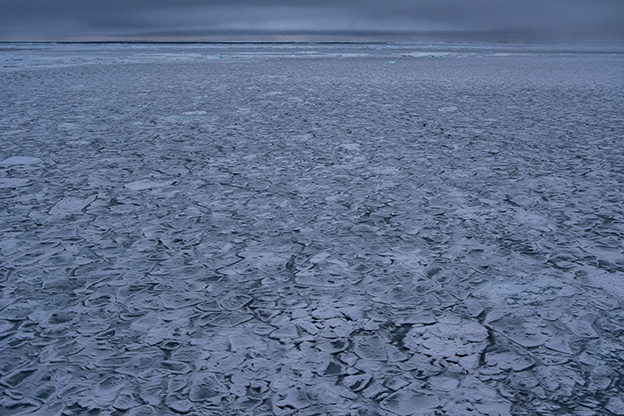Dispatch 8: Salt, Hacky Sacks, Puzzles, and lots of Pancakes!
Elizabeth Bailey
September 23, 2022
Ocean water contains salt, or in other words, it has a salinity. Salinity is an incredibly important property of ocean water as it influences the density of seawater (along with temperature and pressure). Particularly in polar oceans, salinity plays a major role in the vertical structure of density in the water column as changes in density are primarily governed by changes in salinity. In the Arctic Ocean, as you go down in depth, the curves of salinity and density are similar in shape and structure. We make measurements of salinity in a variety of ways.
On the CTD there is a conductivity sensor and during a CTD cast, water flows past the conductivity sensor and is pumped through the CTD as the entire instrument is being lowered and raised through the water column. What is conductivity? Conductivity is one way of determining the salinity of ocean water. To put it simply, conductivity is how well a substance is able to conduct an electric current. Since ocean water contains dissolved salts, ocean water is also able to conduct electrical currents. There are many different salts that are dissolved in ocean water, and they take the form of ions (substances with a positive or negative charge due to the loss or gain of an electron). The two main ions in seawater are chloride (CL-) and sodium (Na+).
In addition to the CTD measurements of salinity, we also collect water from the Niskin bottles for salinity analysis that happens on board. In the same lab that dissolved oxygen analysis is performed, there is salinometer that is primarily run by Robyn Taves, an oceanographic technician from IOS (the Institute of Ocean Sciences in Canada’s Department of Fisheries and Oceans). A salinometer works by vacuum pumping a water sample into a tube with metal coils that measure conductivity. From there, a calculation is done to give the salinity of the water sample. The water samples collected from the Niskin bottles that are run through the salinometer can be used to create salinity profiles, as well as check that our Niskin bottles closed at the correct depths.
Apart from science, the ship’s crew and team of scientists pass time in a variety of ways. Puzzles have become a focus for many of us and are generally a team effort. In the board room and the adjoining conference room, the science team have set up all of their computers, general office space, and it’s also where we all work on the current puzzle! Last night, the final pieces (at least those that aren’t missing) of our first puzzle slid into place and now a new puzzle is in pieces next to the finished one.
Another activity that the science team in particular has really started to enjoy the last couple of days is a good season of hacky sacking. For the last 2 days, a few of us have gone out to the helideck and tried our best to kick a hacky sack to one another. There’s been varying degrees of success, but it’s been fun nonetheless!
Finally, we’ve been seeing lots of pancakes! By pancakes, I’m referring to the type of sea ice – pancake ice. During the beginning of the freeze-up, new ice takes many different forms – one of which is known as pancake ice. Pancake ice is formed when new ice, that is only a few centimeters thick, collides with the other new pieces of ice around it, creating round pieces of ice that look like pancakes (hence the name). In the next day or so, we’ll have our first ice station – something we’ve all been looking forward to!
Ocean water contains salt, or in other words, it has a salinity. Salinity is an incredibly important property of ocean water as it influences the density of seawater (along with temperature and pressure). Particularly in polar oceans, salinity plays a major role in the vertical structure of density in the water column as changes in density are primarily governed by changes in salinity. In the Arctic Ocean, as you go down in depth, the curves of salinity and density are similar in shape and structure. We make measurements of salinity in a variety of ways.
On the CTD there is a conductivity sensor and during a CTD cast, water flows past the conductivity sensor and is pumped through the CTD as the entire instrument is being lowered and raised through the water column. What is conductivity? Conductivity is one way of determining the salinity of ocean water. To put it simply, conductivity is how well a substance is able to conduct an electric current. Since ocean water contains dissolved salts, ocean water is also able to conduct electrical currents. There are many different salts that are dissolved in ocean water, and they take the form of ions (substances with a positive or negative charge due to the loss or gain of an electron). The two main ions in seawater are chloride (CL-) and sodium (Na+).
In addition to the CTD measurements of salinity, we also collect water from the Niskin bottles for salinity analysis that happens on board. In the same lab that dissolved oxygen analysis is performed, there is salinometer that is primarily run by Robyn Taves, an oceanographic technician from IOS (the Institute of Ocean Sciences in Canada’s Department of Fisheries and Oceans). A salinometer works by vacuum pumping a water sample into a tube with metal coils that measure conductivity. From there, a calculation is done to give the salinity of the water sample. The water samples collected from the Niskin bottles that are run through the salinometer can be used to create salinity profiles, as well as check that our Niskin bottles closed at the correct depths.
Apart from science, the ship’s crew and team of scientists pass time in a variety of ways. Puzzles have become a focus for many of us and are generally a team effort. In the board room and the adjoining conference room, the science team have set up all of their computers, general office space, and it’s also where we all work on the current puzzle! Last night, the final pieces (at least those that aren’t missing) of our first puzzle slid into place and now a new puzzle is in pieces next to the finished one.
Another activity that the science team in particular has really started to enjoy the last couple of days is a good season of hacky sacking. For the last 2 days, a few of us have gone out to the helideck and tried our best to kick a hacky sack to one another. There’s been varying degrees of success, but it’s been fun nonetheless!
Finally, we’ve been seeing lots of pancakes! By pancakes, I’m referring to the type of sea ice – pancake ice. During the beginning of the freeze-up, new ice takes many different forms – one of which is known as pancake ice. Pancake ice is formed when new ice, that is only a few centimeters thick, collides with the other new pieces of ice around it, creating round pieces of ice that look like pancakes (hence the name). In the next day or so, we’ll have our first ice station – something we’ve all been looking forward to!




